I recently had the opportunity to visit the National Laboratory Center library within the Bureau of Alcohol, Tobacco, Firearms and Explosives. The facility is located in Beltsville, MD and is not open to the public. The opportunity to visit the library at the laboratory center was eye opening in seeing another side of special libraries, the solo librarian in a secure collection serving only agency staff and existing in an invisible realm from the public eye. Photography was prohibited for security reasons, and the library itself does not have a public website. The librarian in Beltsville also provides remote library services to two satellite collections in Atlanta and San Francisco. The collection consists primarily of journals, with about 5,000 monographs stored among the three library locations. There are also some monographs from the early 1900's stored in a locked archive with compact shelving.
The National Laboratory Center library catalog is managed by the The Department of Justice Libraries. Some of these libraries are slightly more accessible to the public, but primarily serve Department of Justice affiliated users. The shared catalog access across the DOJ increases use and access to collections of information for staff at the National Laboratory, as well as across the DOJ.
Another information center, closed to the public but serving a high level of users within its organization is the Defense Technical Information Center, which provides information services to staff and affiliates of the Department of Defense. Their website is fairly robust and contains a great deal of publicly accessible content on defense related topics. Search the database of public technical reportsor the A-Z directory to see what is publicly accessible on the website.
There are many special libraries and information centers staffed by librarians/information professionals that are 'hidden' from the public view, but serve a crucial need for information services within corporations, government agencies, or non-profit organizations. Some have websites and are able to share resources with the public through digital access, some participate in Inter-library loan and make records available through OCLC. Some are inaccessible due to the secure nature of collections or security of the location. These are fascinating repositories of specialized information run by amazing librarians. If you have an opportunity to visit one, or are lucky enough to work in one, appreciate it, because they are a great part of what is special about special libraries.
Saturday, March 31, 2012
ATF National Laboratory Center and Defense Technical Information Center
Location:
Beltsville, MD, USA
Saturday, March 24, 2012
National Oceanic and Atmospheric Administration Central Library
The National Oceanic and Atmospheric Administration (NOAA) has roots as a scientific research agency back to 1807 with the Coast Survey. The NOAA library network provides access to scientific information to NOAA staff, visiting researchers, and members of the public. While the library itself is only accessible by special request for non-NOAA affiliated researchers, much of the collections have been made available online through the central library website, and libraries in the network. See the NOAA Libraries Network to find out more about the national system of NOAA Libraries.

The library uses a union catalog to increase search capabilities to all NOAA collections across the country. NOAA records are also shared in OCLC WorldCat. The central library, and many libraries in the network participate in inter-library loan (ILL) and can provide materials to the general public through ILL requests. The NOAA central library website provides a wealth of information, and access to many aspects of the collection in digital form. See the Collections page for information on virtual libraries, links to digital libraries, and further information on the subject areas of the collection. The library also provides access to reference services to any member of the public through chat, email, or phone.
The library space is a labyrinth containing a vast array of journals, monographs, maps, media, and rare items. To find out more about some of the rare and archival materials at NOAA Central, see this page. I recently volunteered to modify catalog records and reformat some web pages for a digital collection of data. While there I wandered the stacks and snapped some pictures of the shelves, and some of the materials on display.

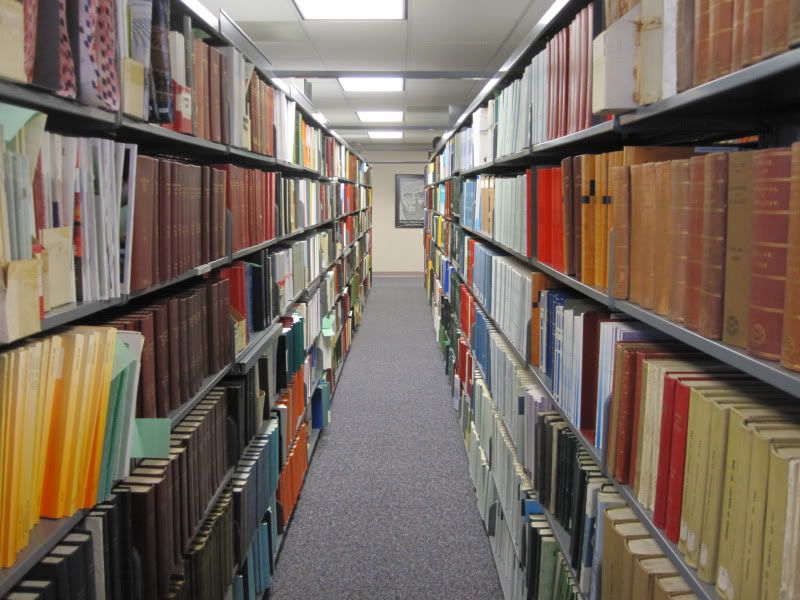


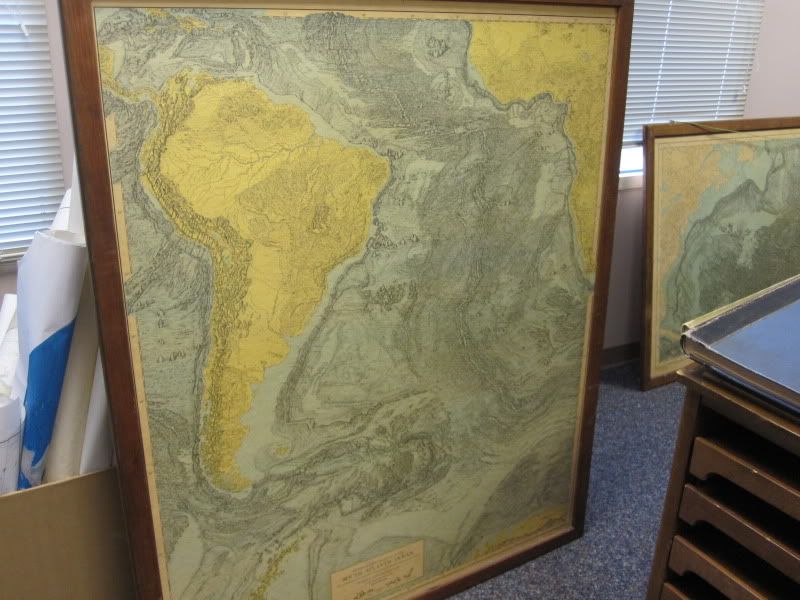

The library uses a union catalog to increase search capabilities to all NOAA collections across the country. NOAA records are also shared in OCLC WorldCat. The central library, and many libraries in the network participate in inter-library loan (ILL) and can provide materials to the general public through ILL requests. The NOAA central library website provides a wealth of information, and access to many aspects of the collection in digital form. See the Collections page for information on virtual libraries, links to digital libraries, and further information on the subject areas of the collection. The library also provides access to reference services to any member of the public through chat, email, or phone.
The library space is a labyrinth containing a vast array of journals, monographs, maps, media, and rare items. To find out more about some of the rare and archival materials at NOAA Central, see this page. I recently volunteered to modify catalog records and reformat some web pages for a digital collection of data. While there I wandered the stacks and snapped some pictures of the shelves, and some of the materials on display.





Labels:
Astronomy,
federal library,
rare books,
science,
Special Library,
technology,
virtual library
Location:
Silver Spring, MD, USA
Monday, March 19, 2012
Information Center at Pugt Sound Regional Council
Puget Sound Regional Council (PSRC) is the municipal planning organization for the Puget Sound Region. The council is made up of a number of committees that affect growth and development in the north Puget Sound region. The website is a valuable resource for information on transportation, growth management, and economic development in the region. There is also an extensive amount of research available through the links to data resources.
The Information Center at PSRC is "is a clearinghouse for PSRC’s regional data and publications on population, housing, economy, and transportation." The information center is open to the public Monday - Friday during normal business hours. The center primarily provides access to agency publications to the public. The document library can be accessed here, and you can submit a form request to the library to have a print copy of most documents mailed to you. The library staff has also curated an extensive list of useful links for information on a variety of transportation, economic development, and growth management resources on the web.
The information center houses a small collection of monographs and serials which are accessible to the public visiting in person, but are only circulated to agency staff. The library staff are very knowledgeable about the collection and data resources for Census information, and information about the Puget Sound region and Washington State. If you are looking for information about cities, the region, planned growth, projects, or development, drop by during office hours or contact the library staff. To keep up with agency information, you can follow them on Twitter or subscribe to RSS feeds. Here is a photograph of agency resources in the Information Center taken by PSRC staff.

The Information Center at PSRC is "is a clearinghouse for PSRC’s regional data and publications on population, housing, economy, and transportation." The information center is open to the public Monday - Friday during normal business hours. The center primarily provides access to agency publications to the public. The document library can be accessed here, and you can submit a form request to the library to have a print copy of most documents mailed to you. The library staff has also curated an extensive list of useful links for information on a variety of transportation, economic development, and growth management resources on the web.
The information center houses a small collection of monographs and serials which are accessible to the public visiting in person, but are only circulated to agency staff. The library staff are very knowledgeable about the collection and data resources for Census information, and information about the Puget Sound region and Washington State. If you are looking for information about cities, the region, planned growth, projects, or development, drop by during office hours or contact the library staff. To keep up with agency information, you can follow them on Twitter or subscribe to RSS feeds. Here is a photograph of agency resources in the Information Center taken by PSRC staff.

Labels:
business,
economic development,
growth management,
Seattle,
Special Library,
transportation,
virtual library
Location:
Seattle, WA
Sunday, March 18, 2012
National Institute of Standards and Technology Library
I recently had the opportunity to tour the National Institute of Standards and Technology library, museum, and archive in Gaithersburg, MD. Unfortunately, I did not take any pictures on the tour. Here is a picture of the external building from the NIST library website:

The library building also houses a museum collection with artifacts from NIST history, such as the official meter stick, and the very first neon sign. The library staff has developed a digital museum with collections, as well as photographic representations of museum artifacts. The current featured collection is Standardization of Women's Clothing. See their photo gallery for collections of photographs from the museum collection.
The NIST campus is not open to the public, however some access to NIST publications is available through request from the website. Requests to visit the museum are granted in special cases. See the Library FAQ section for more information. The library does offer a vast amount of information about the collections through their virtual library portal. The library is an amazing collection of scientific research and technology information. The collections are primarily for use by staff, however the reference librarians may respond to information requests, or direct users to publicly accessible resources for information.
The campus itself is also interesting, in that it is a secure facility that has become somewhat of a nature preserve. The grounds are kept fairly natural, and contain numerous deer and other wildlife. In 1966 when the agency moved to the Gaithersburg campus, a direct decedent to the famous Apple tree which inspired Sir Issac Newton. I'm told the apples taste a bit mealy and aren't very good.

The library building also houses a museum collection with artifacts from NIST history, such as the official meter stick, and the very first neon sign. The library staff has developed a digital museum with collections, as well as photographic representations of museum artifacts. The current featured collection is Standardization of Women's Clothing. See their photo gallery for collections of photographs from the museum collection.
The NIST campus is not open to the public, however some access to NIST publications is available through request from the website. Requests to visit the museum are granted in special cases. See the Library FAQ section for more information. The library does offer a vast amount of information about the collections through their virtual library portal. The library is an amazing collection of scientific research and technology information. The collections are primarily for use by staff, however the reference librarians may respond to information requests, or direct users to publicly accessible resources for information.
The campus itself is also interesting, in that it is a secure facility that has become somewhat of a nature preserve. The grounds are kept fairly natural, and contain numerous deer and other wildlife. In 1966 when the agency moved to the Gaithersburg campus, a direct decedent to the famous Apple tree which inspired Sir Issac Newton. I'm told the apples taste a bit mealy and aren't very good.
Labels:
federal library,
museum,
science,
technology,
virtual library
Location:
Gaithersburg, MD, USA
Friday, March 16, 2012
Theosophical Society of Seattle Lending Library
This special library is a bit off the beaten path in Seattle's Capitol Hill Neighborhood. I came across this library while searching for volunteer opportunities in libraries on Volunteer Match prior to graduate school.The Theosophical Society was founded in 1875, and operates under three primary tennants,
1. To form a nucleus of the universal brotherhood of humanity, without distinction of race, creed, sex, caste, or color
2. To encourage the comparative study of religion, philosophy, and science
3. To investigate unexplained laws of nature and the powers latent in humanity.
H.P. Blavatsky is the originating founder of the philosophy, published extensive volumes about philsophy, the theosophical society, and the occult, and is in general an interesting person you should look up and read a biography on sometime. You can check several out at The Theosophical Society in Seattle Lending Library, after paying the $30 annual membership fee. Membership fees for lending are a primary source of income for the library. The staff consists mostly of volunteers, and the space is also used as the lodge for the Seattle chapter of the Theosophical Society. The library is found behind the The Quest Bookshop and is a relaxing oasis within a very busy and vibrant neighborhood. It is worth checking out the collection and space, and the membership is a reasonable price to pay to keep this non-profit going for access to an enormous collection of about 7,000 items about philosophy, theology, the occult, founding members, and various scientific topics. Contact the librarian if you are interested in volunteering. They could always use more helpers with "overseeing the library during open hours; book repair; shelf reading, and the accessioning of new books" according to their website.
These pictures were taken in 2009 when I volunteered as the librarian on Sundays.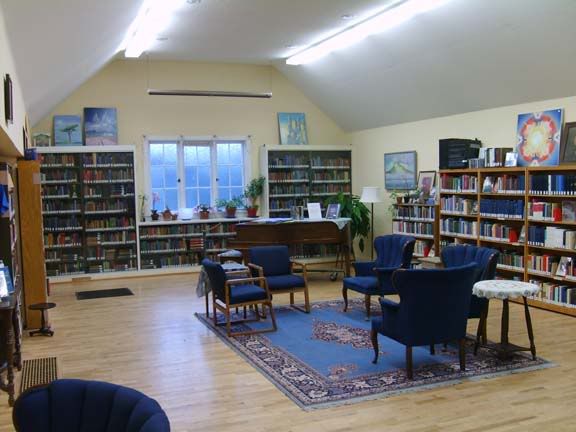
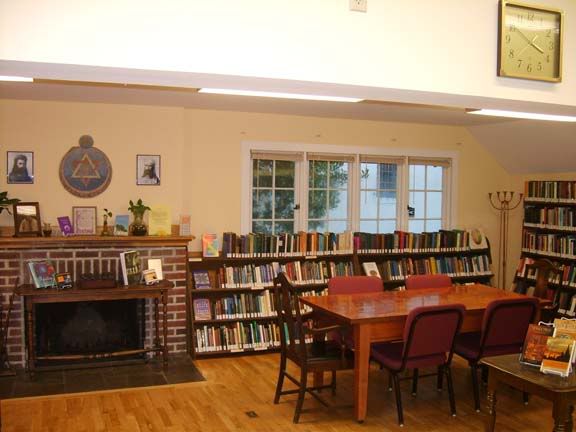
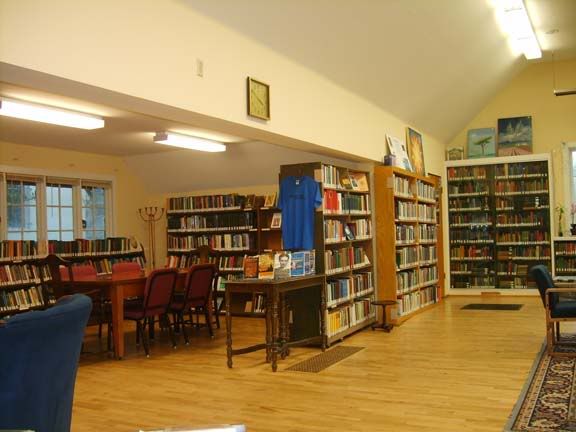
1. To form a nucleus of the universal brotherhood of humanity, without distinction of race, creed, sex, caste, or color
2. To encourage the comparative study of religion, philosophy, and science
3. To investigate unexplained laws of nature and the powers latent in humanity.
H.P. Blavatsky is the originating founder of the philosophy, published extensive volumes about philsophy, the theosophical society, and the occult, and is in general an interesting person you should look up and read a biography on sometime. You can check several out at The Theosophical Society in Seattle Lending Library, after paying the $30 annual membership fee. Membership fees for lending are a primary source of income for the library. The staff consists mostly of volunteers, and the space is also used as the lodge for the Seattle chapter of the Theosophical Society. The library is found behind the The Quest Bookshop and is a relaxing oasis within a very busy and vibrant neighborhood. It is worth checking out the collection and space, and the membership is a reasonable price to pay to keep this non-profit going for access to an enormous collection of about 7,000 items about philosophy, theology, the occult, founding members, and various scientific topics. Contact the librarian if you are interested in volunteering. They could always use more helpers with "overseeing the library during open hours; book repair; shelf reading, and the accessioning of new books" according to their website.
These pictures were taken in 2009 when I volunteered as the librarian on Sundays.



Labels:
Member Society,
occult,
philosophy,
rare books,
religion,
science,
Seattle,
Special Library
Location:
Seattle, WA, USA
Thursday, March 15, 2012
The James Melville Gilliss Library
The James Melville Gillis Library collection dates from 1830. The library was developed as part of the US Naval Observatory, and today is found in the main building, built in 1893, and sits on hilly ground in the Georgetown area of Washington, DC. A brief history of the observatory can be read here. The library is housed in the wing on the right of this photo of the main building on the grounds as seen in this picture taken from the library website.

As you enter the building and are greeted with display cases on the right and left showcasing items from the collection, you may feel as if you are walking back in time. Pass the telescope and take a right down a hallway with high arched ceilings for the first glimpse of the space through large double iron gates.
 This image is taken from the James Melville Gillis Library collection online. The following images were taken during a tour with the library manager, Sally Bosken.
This image is taken from the James Melville Gillis Library collection online. The following images were taken during a tour with the library manager, Sally Bosken.


The library itself is generally closed to the public because of security on the grounds. Many items are available through inter-library loan, or researchers may visit upon special request. The library has two staff who work with the naval staff on site and assist with research, publications, and information access. The collections focus on astronomy and hard science, publications of the US Naval Observatory, and contain both print and electronic resources. The library also maintains an amazing collection of over 800 pre-19th century rare books, including works by Galileo, Copernicus, Einstein and Newton. The library is architecturally and historically fascinating. The grounds are beautiful. This is indeed a special place, and an amazing special library.
The library does occasionally take on volunteers. If you are a library science current student or recent graduate interested in astronomy collections, cataloging rare books, or other possible projects please contact the library using their online request form.
The Vice President lives on the grounds, and the library space is often used for for special events such as dinners or vice presidential interviews. These are pictures of the view from the telescope roof on the left side wing of the building, of the telescope still used to mark official US time, and the telescope inside the dome on the main observatory building.



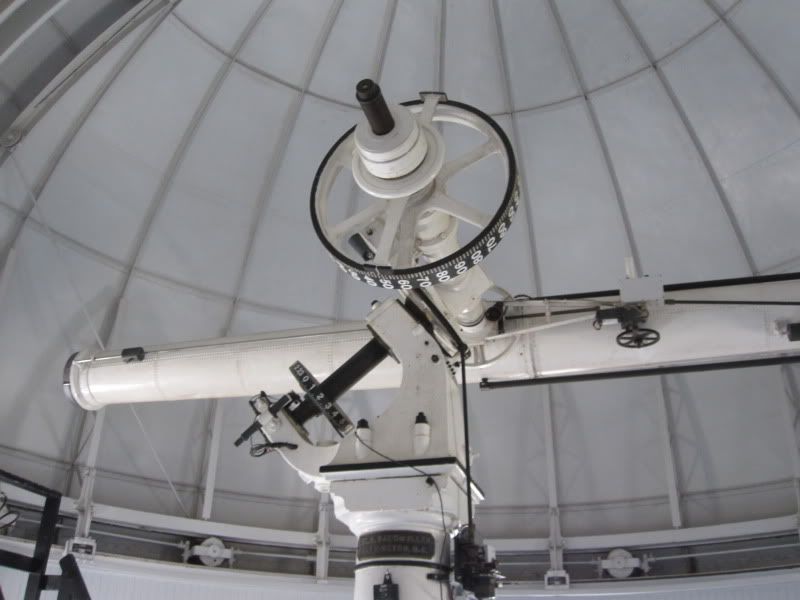

As you enter the building and are greeted with display cases on the right and left showcasing items from the collection, you may feel as if you are walking back in time. Pass the telescope and take a right down a hallway with high arched ceilings for the first glimpse of the space through large double iron gates.
 This image is taken from the James Melville Gillis Library collection online. The following images were taken during a tour with the library manager, Sally Bosken.
This image is taken from the James Melville Gillis Library collection online. The following images were taken during a tour with the library manager, Sally Bosken.

The library itself is generally closed to the public because of security on the grounds. Many items are available through inter-library loan, or researchers may visit upon special request. The library has two staff who work with the naval staff on site and assist with research, publications, and information access. The collections focus on astronomy and hard science, publications of the US Naval Observatory, and contain both print and electronic resources. The library also maintains an amazing collection of over 800 pre-19th century rare books, including works by Galileo, Copernicus, Einstein and Newton. The library is architecturally and historically fascinating. The grounds are beautiful. This is indeed a special place, and an amazing special library.
The library does occasionally take on volunteers. If you are a library science current student or recent graduate interested in astronomy collections, cataloging rare books, or other possible projects please contact the library using their online request form.
The Vice President lives on the grounds, and the library space is often used for for special events such as dinners or vice presidential interviews. These are pictures of the view from the telescope roof on the left side wing of the building, of the telescope still used to mark official US time, and the telescope inside the dome on the main observatory building.




Labels:
Astronomy,
federal library,
Manuscripts,
maps,
rare books,
science,
Special Library,
technology
Location:
Washington, DC, USA
Subscribe to:
Posts (Atom)